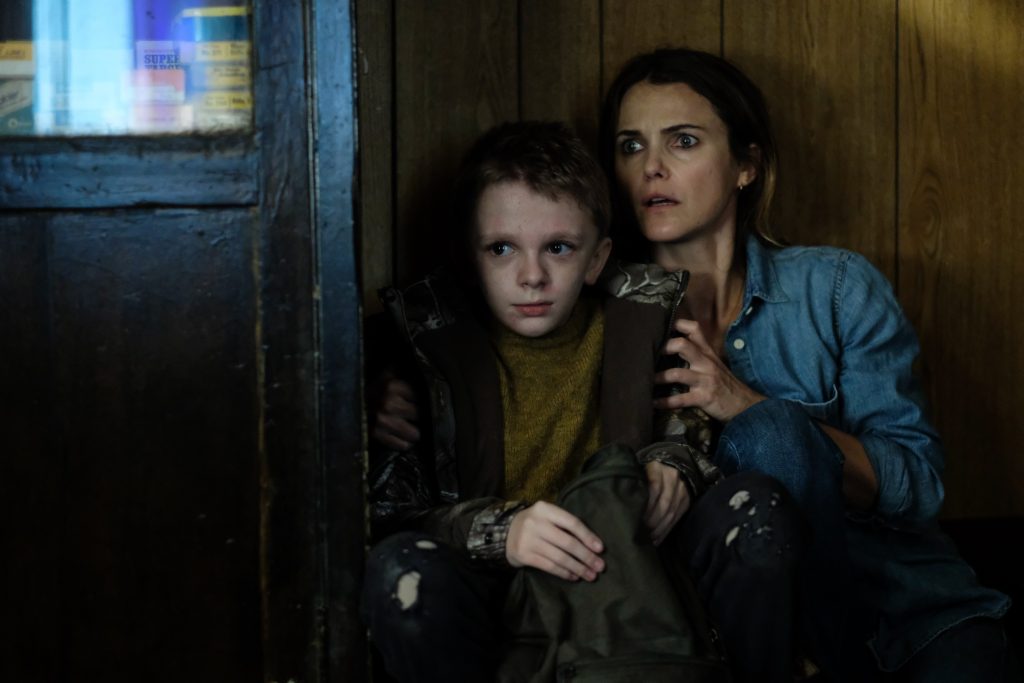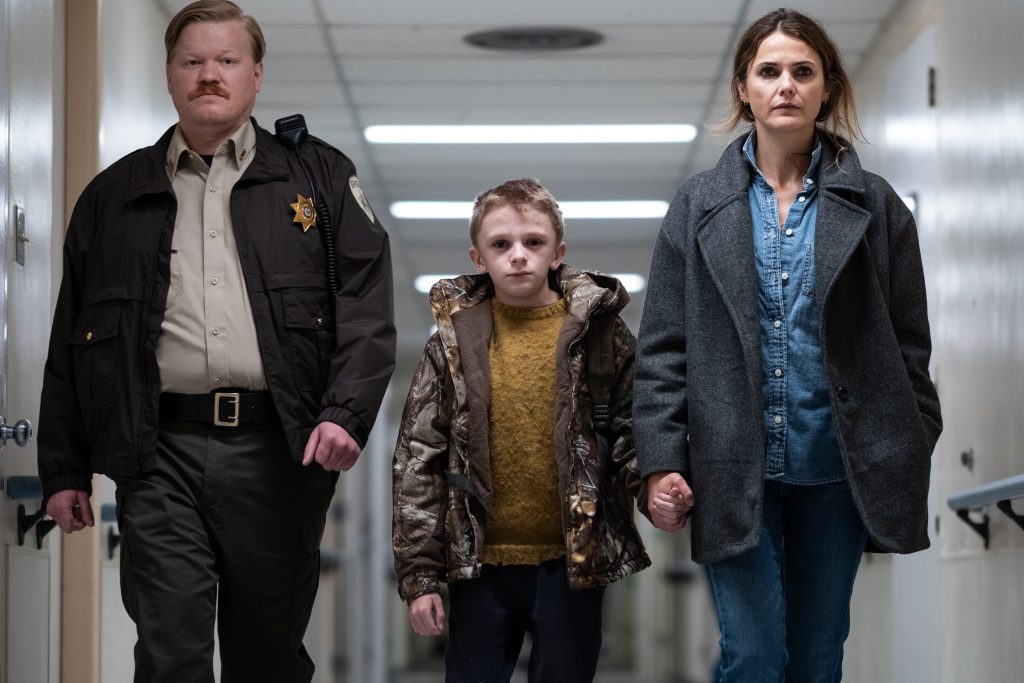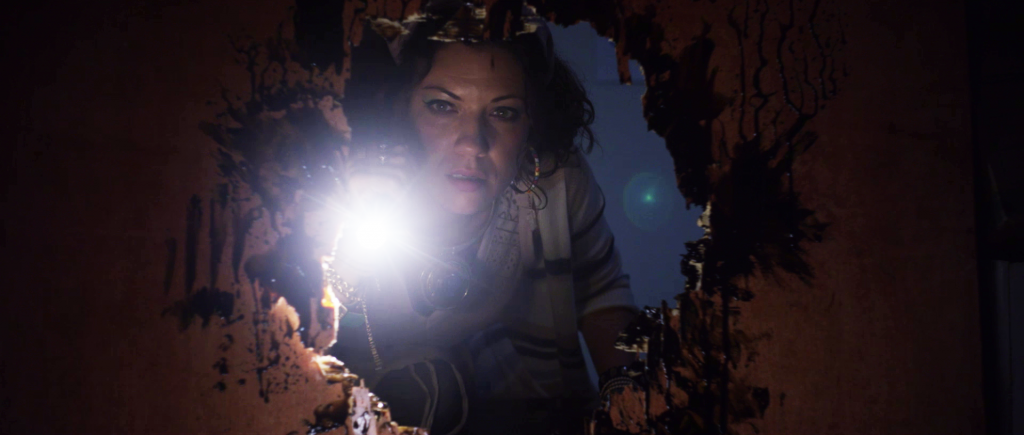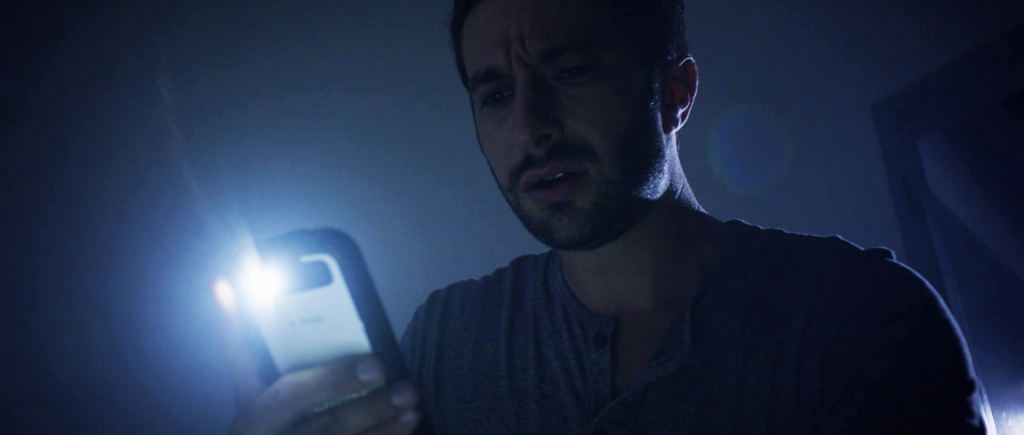March 6, 2022
by Carla Hay

Directed by Gilles de Maistre
Culture Representation: Taking place primarily in unnamed cities in Canada and briefly in New York City, the dramatic film “The Wolf and the Lion” features a predominantly white cast of characters (with a few indigenous people) representing the working-class and middle-class.
Culture Clash: An aspiring classical pianist illegally raises a wolf and a lion in her home, and she has conflicts with people who want to take these wild animals away from her.
Culture Audience: “The Wolf and the Lion” will appeal primarily to people who don’t mind watching ridiculous and extremely corny movies about people’s interactions with wild animals.
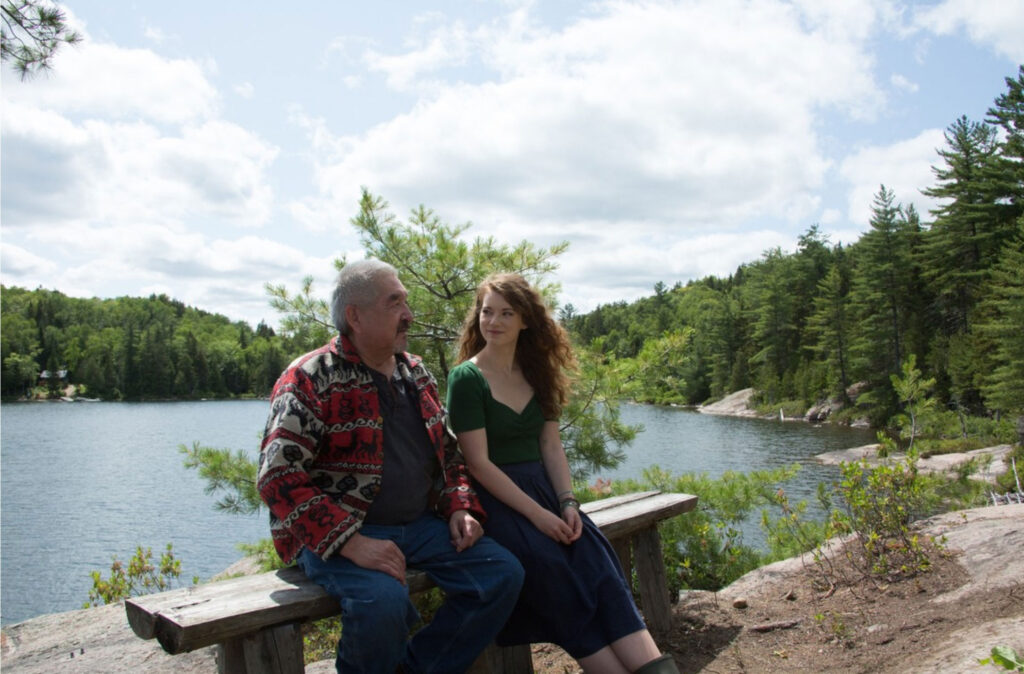
Extremely vapid on every level, “The Wolf and the Lion” is a poorly made drama that irresponsibly advocates for untrained people to raise large wild animals, such as a wolf and a lion, inside their homes. This amateurish-looking movie foolishly makes it look like people with enough love in their hearts for animals are automatically qualified to raise wild animals as if they’re domesticated pets. And according to “The Wolf and the Lion,” anyone who tries to take these animals out of these dangerous situations is automatically a villain.
That’s the entire story presented in “The Wolf and the Lion,” a horrendously cornball movie filled with the worst possible stereotypes of family-oriented animal movies, in order to warp reality and make it look like wolves and lions can be cuddly pets in the household. While “The Wolf and the Lion” has heavy-handed preaching about animal abuse in circuses, most of the movie hypocritically ignores the fact that keeping large wild animals cooped up in a house, instead of letting them roam free in their natural habitats, is another form of animal abuse. That’s one of many examples of how tone-deaf and idiotic this subpar film is.
Even though the titular wolf and lion in the movie were raised together in real life and actually are in the movie (as opposed to be being entirely created by visual effects), everything else about this story is very phony. The animals aren’t real in every scene though. There are some obvious cheap-looking CGI effects when the animals do unrealistic stunts.
In this world created in “The Wolf and the Lion,” viewers are supposed to believe that it should be perfectly normal to let these wild animals wander around unchecked and unsupervised in places where people and domesticated pets could genuinely be hurt or killed by these predatory animals. It might be acceptable if “The Wolf and the Lion” were a movie in the fantasy genre, but this movie was created to simulate the real world and to depict how wild animals should be handled by humans. Unfortunately, everything in this worthless movie is mishandled.
“The Wolf and the Lion” was directed by Gilles de Maistre and written by his wife Prune de Maistre. This husband-and-wife filmmaking duo can be blamed for unleashing (no pun intended) other low-quality, irresponsibly depicted animal movies on the public. Their other film credits include 2018’s “Mia and the White Lion” and “Jaguar My Love,” whose release date is to be announced.
In “The Wolf and the Lion,” which takes place in unnamed cities in Canada and briefly in New York City, the central human character is Alma (played by Emily Kunz), an aspiring classical pianist who’s in her early 20s. Alma was raised by her widower grandfather because her parents died when she was a very young child. In the beginning of the movie, viewers find out that Alma’s reclusive grandfather (her last living relative) has died, and she has inherited his small house in a remote wooded area in Canada, where she grew up with her grandfather.
Alma travels from New York City, where she’s been living for an untold period of time, to check out the house and deal with some legal matters related to her modest inheritance. When she arrives back in her hometown, she’s greeted by her godfather Joe (played by Graham Greene), who lives nearby and encourages her to stay at the house where her grandfather lived. Alma agrees because she’s reluctant to go back to New York City, where she has an important music competition that has made her nervous because she’s afraid of failing.
Soon after arriving at the house, Alma sees home videos made by her grandfather, where he mentions that he made a new friend: a female snow wolf that he has not named. The wolf is shown in the videos roaming free in the nearby wooded area. And it’s at this point you know exactly who will be the mother of the wolf cub that Alma encounters later in the movie.
Around the time that Alma has settled into her new home, the same snow wolf is seen being tracked by two men who’ve been looking for a rare snow wolf. They are a scientist named Eli (played by Charlie Carrick) and an expert hunter/tracker named Charles (played by Derek Johns), who was hired by Eli for this trip in the woods. Eli runs a program where wild animals can be studied and re-introduced into the wild. Charles and Eli know there’s a snow wolf in the area and have set a trap.
And what about the lion in this movie? The movie’s opening scene shows a hunter (played by Frank Schorpion) shooting and killing a lioness, in order to take her cub. This male cub is going to be sold to a circus. The hunter takes the cub on a small private plane that he is piloting. He’s the only human on the plane. The plane crashes and the pilot is injured but unconscious, while the cub survives and falls into a tree.
Meanwhile, the trap that Charles and Eli have set has caught the snow wolf. Alma happens to see the trapped wolf when she’s walking in the woods, so she sets the wolf free by using a pocket knife. Alma also encounters Charles and Eli, who admit that they are looking for a snow wolf. She yells at them for illegally trapping the wolf, and she orders them to leave because they’re trespassing on private property.
Almost as soon as Charles and Eli leave, something happens that looks like it could only be in a movie: The orphaned lion cub literally falls from the tree right into Alma’s arms. Yes, it’s that kind of movie. Of course, Alma loves animals, so she decides to take the cub home with her, where she feeds meals to the cub, such as meat and bottled milk.
Soon after finding the cub, another “only in a movie” moment happens: The snow wolf that Alma rescued shows up at her door with her male cub. And so, Alma takes in these two other animals too, as if her home is suddenly the local menagerie. Alma knows what she’s doing is illegal, but she doesn’t care, because misguided heroines in badly written animal movies cannot be stopped.
Eventually, mountain rangers come knocking on Alma’s door, because the circus that was expecting the lion cub has reported the cub missing, and the rangers want to know if Alma has seen the cub. The pilot was taken to a hospital and has told authorities about the general area where he thinks the lion cub could be. The lion cub was already microchipped by the pilot as a way to identify the cub if it’s found.
Alma was raised by her grandfather to be an animal advocate opposed to circuses. And so, when she finds out that the cub was captured to go to a circus, she lies to the mountain rangers and says that she hasn’t seen the cub. However, Alma’s godfather Joe eventually finds out that Alma is illegally keeping three wild animals in her home. He doesn’t approve, but he doesn’t report what he knows either.
The movie has an unnecessary subplot about how one of the mountain rangers, whose name is Ysae (played by Rebecca Croll), is an ex-girlfriend of Joe’s. Ysae broke up with Joe (it’s hinted that he cheated on her), and she’s very bitter about the breakup. And guess who’s going to be the ranger who’s the most fired-up about finding this lion and turning it over to the circus? It’s all just so contrived, in order for these two ex-lovers to be on opposite sides of this inevitable battle over the lion.
While Alma acts like she thinks she’s Dr. Dolittle, Alma reluctantly has to go to New York City for the music competition that she’s dreading at St. Mary’s Academy of Music Fest. The competition is essentially an audition for a job with the Los Angeles Philharmonic Orchestra. And so, Alma leaves all three of the animals alone in the house with enough food and water while she goes away for a few days. Viewers will be cringing at this horrible decision to leave these animals in the house unsupervised.
And it should come as no surprise that something terrible does happen: While Alma is away on her trip, the mother wolf escapes from the house and gets captured by Eli and Charles in the woods. The two cubs, left to their own devices, end up trashing the house. When Alma comes back, she’s shocked to find out that the mother wolf is missing and that these wild cubs have destroyed many things in her home. Alma tries to find the mother wolf but can’t because Alma has no idea at the time that the wolf has been taken somewhere else.
Knowing that she’s in way over her head, Alma calls a rescue group, whose specialty is wild animals, to see if the group can take these unruly cubs. However, the rescue group tells her that the animal sanctuary it works with in South Africa is no longer accepting cubs. Of course, because this movie is all about an untrained Alma raising this wolf and lion by herself, she gives up on finding any rescue groups that can take these animals. Alma decides to permanently keep the wolf (whom she names Mozart) and the lion (whom she names Dreamer) so that they can all live happily ever after.
Alma did well in the music competition, but she decides not to take the L.A. Philharmonic Orchestra job that was offered to her. She tells Joe that although she still loves music, she no longer wants to be in an orchestra. After all, if Alma had an orchestra job, that would ruin the movie’s narrative of Alma having the time to be the saintly rescuer of wild animals. Somehow, she raises Mozart and Dreamer to young adulthood and manages it to keep it a secret, because the only person who visits her is Joe, who has a “don’t ask, don’t tell” attitude about this secret. (In real life, the wolf’s name is Paddington, and the lion’s name is Walter.)
But since this movie has to pile on some melodrama, there comes a point in time when the secret is revealed. Alma lives fairly close to a lake, where one day a mother and underage daughter (played by “The Wolf and the Lion” screenwriter Prune de Maistre and her real-life daughter Neige de Maistre) are in a boat by themselves on the lake. At this point in time, Mozart and Dreamer are young adults (about one or two years old), who frolic together unleashed in the woods.
Alma sees these two strangers in the boat, and she panics because she knows that Mozart and Dreamer are running wild nearby. And sure enough, the mother and daughter see the wild animals on the land, just as Alma is running to try to prevent the animals from being seen. Alma is so panicked that she falls, hits her head on a rock, and loses consciousness.
Alma wakes up to find out that the authorities have arrived and taken the animals away. Mozart is taken to Eli’s science observation place where Mozart’s mother is, because scientist Eli gets involved and convinces the authorities that Mozart is better off being with his mother. Dreamer is taken to the circus that had purchased Dreamer and has a legal right to own the lion. Luckily for Alma, she’s not arrested, but she’s told that she will be arrested if she tries to keep wild animals on her property again.
But do you think this threat of arrest will stop Alma? Of course not. The rest of the movie is about her trying to find Dreamer and trying to convince Eli to give her custody of Mozart. Eli thinks Alma is mentally ill. For obvious reasons, the authorities don’t tell Alma the name of the circus that has Dreamer. And so, there’s a long stretch of the movie where Alma plays detective, by making phone calls and eventually taking a road trip, going from circus to circus to try to find Dreamer.
The name of the circus that has Dreamer is Allan Elreve Circus, named after its predictably villainous owner Allan Elreve (played by Evan Buliung), who cruelly abuses the animals that he trains for the circus. Allan is also teaching his son Rapha (played by Rhys Slack), who’s about 10 or 11 years old, that this violent and sadistic way of training animals is the correct and only way. Rapha is very uncomfortable with this animal cruelty, and he feels especially protective of the young male lion that has recently been brought to the circus.
Alma isn’t the only one looking for Dreamer. Mozart is too. “The Wolf and the Lion” is so laughably bad, there are some things that happen in the movie that are almost cartoonish. This wolf suddenly becomes a detective too and somehow can plan a rescue mission all by himself. And so-called professional animal handlers and authorities are made to look like bungling and flaky morons.
“The Wolf and the Lion” would be easier to take if the movie had been intended to be a comedic adventure story. Instead, it’s a continuous and irritating pile-on of sappy and sloppily filmed melodrama (including embarrassing performances by the entire cast), as if the filmmakers think that “The Wolf and the Lion” is important family-oriented cinematic art. The reality is that “The Wolf and the Lion” endorses actions that are dangerous to people, and this terrible film is an insult to people’s intelligence, no matter what age you are.
Blue Fox Entertainment released “The Wolf and the Lion” in U.S. cinemas on February 4, 2022. The movie was released in Europe in 2021.

